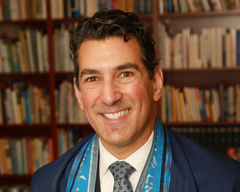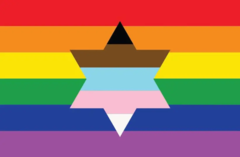living in an age of uncertainty
09/07/2021 01:00:00 PM

Sermon - Rosh Hashanah 5782
After the destruction of the ancient Temple in Jerusalem and the exile of the Jewish people to Babylon, Jeremiah shared these powerful words: “There may yet be hope—Ulai yeish tikvah.”[1] In the most uncertain times, the ancient prophet made space for two sometimes hard-to-reconcile feelings: uncertainty and hopefulness.
The Jewish people have some experience with uncertainty, so there’s much guidance to be found in our faith. It’s not that you can open the Hebrew Bible and search “What to do while living during a pandemic?” But we can learn how our ancestors coped when life felt particularly precarious.
We come from a long line of resilient people, and a lesson in resiliency is important now, because human beings aren’t good at living with uncertainty. We want to feel in control and have a plan. It is stressful and draining to continually need to consider, recalibrate, and reassess new levels of risk tolerance in a constantly changing landscape.
Psychologist Betsy Stone explains we are facing a wave of cascading traumas—including pandemic, natural disasters, wildfires, and a rise in antisemitism and anti-Zionism. She teaches that we experience trauma in a primitive part of the brain, the amygdala, or fear center, whose job is to keep us alive. Some are seeing a significant disruption in sleep, and that’s our brain’s way to protect us from external risk. If a saber-toothed tiger is out there, sleeping soundly is not a good idea. Our brains remember our ancestors dying from famine, so instinctively we eat everything in sight, which explains the pounds many of us have gained. Similar instincts led us to hoard, especially at the pandemic’s beginning. Times may be uncertain, but at least I’ve got a lot of paper towels.
Our brain is an organ that hasn’t developed dramatically in recent Millenia, which also helps explain COVID brain—the inability to think straight, coupled with a shortened attention span. For me, it can be turning to my wife, Sandra, to say something and then forgetting what I wanted to say. Or inexplicably taking the lid off the salad spinner before it has stopped spinning. Many of us feel numb. Others are experiencing emotional extremes and are more explosive, weepy, impulsive, or are finding it difficult to regulate themselves.[2]
The notion of living in uncertain times is a subject that twentieth century Jewish philosopher Zygmunt Bauman wrote about, noting a shift from what he called `solid’ to `liquid’ modernity, with new and unprecedented challenges. What an interesting metaphor. Our member, Dan Kurzrock, used the same metaphor when he wrote a beautiful poem in the wake of the Tubbs Fire that consumed our Camp Newman in Santa Rosa. “We are water, not wood,” he wrote, hinting at our ability to adapt, change, and recreate ourselves and our surroundings.[3]
There is something beautiful about water representing who and what we are. Like a stream or river that joins other bodies of water to create a new and larger one, we are constantly evolving. And like water that has flowed far, we cannot go back to who we were. We can only accept our new reality, our new selves.
Sometimes that newness can feel like too much. There’s a Peanuts cartoon that was printed recently. Charlie Brown wakes up his younger sister Sally for the first day of school and she leaps out of bed gripped with anxiety. “I don’t know where Italy is! I can’t spell ‘cavalry’! Who was the father of Richard the Fiftieth? . . . Where’s my lunch money? I need answers! How can I go to school if I don’t know any of the answers?”
Charlie Brown answers her gently, “You don’t have to know the answers . . . that’s why you go to school. School is for learning.”
“Ha!” Sally harumphs.
Like Sally, I find myself wanting to say “Ha!” We all want answers, but life keeps throwing us more questions.
Two dominant metaphors in Jewish life from the Torah are the notions of being in Mitzrayim and the midbar—being in Egypt and the desert. Our ancestors were slaves in Egypt, Mitzrayim, which in Hebrew means a place of constraints or narrowness. The ancient Hebrews were beaten down, and the Book of Exodus tells us that eventually their cries were heard by God. But their liberation was not swift, coming only after Moses played a role in the deliverance of the ten plagues. Only then did Moses lead the people to the Sea of Reeds. But to be redeemed, they had to play an active role. And even then, when they chose to enter the water, the journey was not straight and easy.
Instead of the direct route to Canaan, which would have taken only about eleven days, they spent forty years wandering in the desert. Life in the desert was so uncertain and difficult that they would long for Egypt. But without the time in the desert, there would have been no entry into the land of milk and honey.
Our tradition reminds us that the path to the land of plenty goes through the desert. Throughout the ages, we have been able to see our current travails in relation to these ancient stories of fortitude and resilience. Our people, then and now, could relate to the idea of not being there yet, of being in the in-between, of not being settled.
Like so many of us, this has been a very challenging time for me. During the long months of quarantine, I missed people—my extended family, circles of friends, the people with whom I share my sacred work, and this wonderful Peninsula Temple Sholom community. I missed real contact with people, the sharing of hugs, and the meaningful conversations that take place when we are in person.
The constant calculating of the right level of risk has been exhausting. Trying to hold this blessed community together and engaged in all that we do here at PTS while keeping everybody safe has taken a toll. I felt the loneliness, the weight of trying to make the right decisions, and the pressure of looking like I had it all together. I felt deep pain having pastored to so many who faced dark and difficult times during the pandemic. Many have lost loved ones and were denied the opportunity to mourn with a community. My heart has ached.
I found great solace, though, in this teaching of Rabbi Menachem Mendl of Kotzk, who taught in the nineteenth century the “only whole heart is a broken one.”[4] When we let the world, and our life experiences, break down the walls we build around our heart, that’s when our heart is the most complete—when we are most fully human.
The goal is not to fix our broken hearts. As author Michal Oshman writes, “I was never supposed to mend my brokenness, to try to get back to what I was before. Not only is that impossible, but now my brokenness is part of me. It makes me more complete.”[5] This may be what the psalmist meant with these words: “Adonai is close to the broken-hearted.”[6] This last year has left all of us a little broken-hearted.
I believe brokenness can be as asset. The ability to be vulnerable, open, and honest is the key to our High Holy Day spirit of return and renewal. We come clean before our consciences and God, and when we turn toward God, God turns toward us. During these sacred days of reflection, I urge each of us to embrace our broken hearts, open those hearts to each other, and to God. Only by acknowledging our own brokenness can we, like water, begin to flow into something new, something bigger, and something even more beautiful.
Listen to these words from a prayer said in preparation for the High Holy Days:
“The sea pushes back off the shore,
yielding to gravity with a sigh,
not a leaving but a letting go,a retreat into its own deep fullness.
The sun relinquishes its hold on the sky
only to rise once more at daybreak
as the tide rolls back in,
a different kind of letting go,
an unspooling across the expanse.
And we creatures of earth are granted a fresh start,
a chance to gather the debris
and shape the world anew.
Wholeness is a kind of holiness,
the stasis of perfection.
But brokenness demands re-creation,
a churning cycle of endings and beginnings,
the act of pulling hope and brightness from the wreckage,
taking the jagged shards and making of them,
if not wholeness, a new sort of sacred splendor.”[7]
My prayer and hope for this community at the dawn of the new year is that we use our jagged shards to create a new sense of wholeness, a new kind of sacred splendor. Cain yehi ratzon. So may this be God’s will. Amen.
[1] Lamentations 3:29, The Jewish Study Bible (Oxford: Oxford University Press, 2004), 1597.
[2] Betsy Stone, Central Conference of American Rabbis Elul Webinar, Opening My New Heart: Who Are We Now?, August 23, 2021.
[3] Daniel Kurzrock, We are Water, 2017.
[4] Kerry M. Olitzky and Rachel T. Sabath, Preparing Your Heart for the High Holy Days (Philadelphia: The Jewish Publication Society, 1996), 54.
[5] Michael Oshman, What Would You Do If You Weren’t Afraid? (New York: Penguin Random House, 2021), 94.
[6] Psalm 34:19 The Jewish Study Bible (Oxford: Oxford University Press, 2004), 1319.
[7] Editors Rabbis Janet Marder and Rabbi Sheldon Marder, Mishkan Halev (New York: Central Conference of American Rabbis, 2017), 61.






